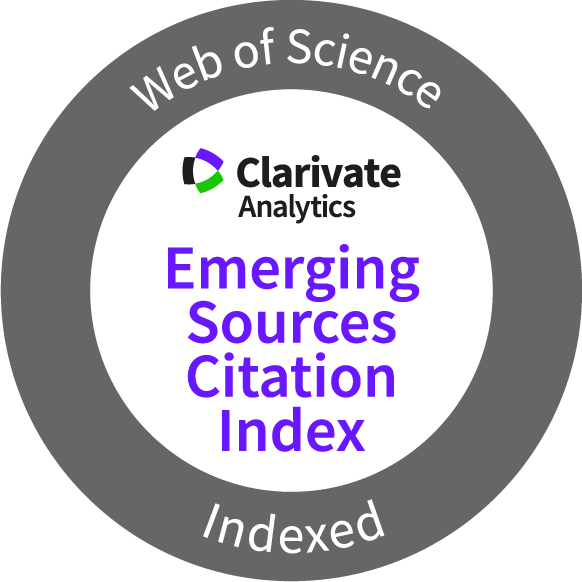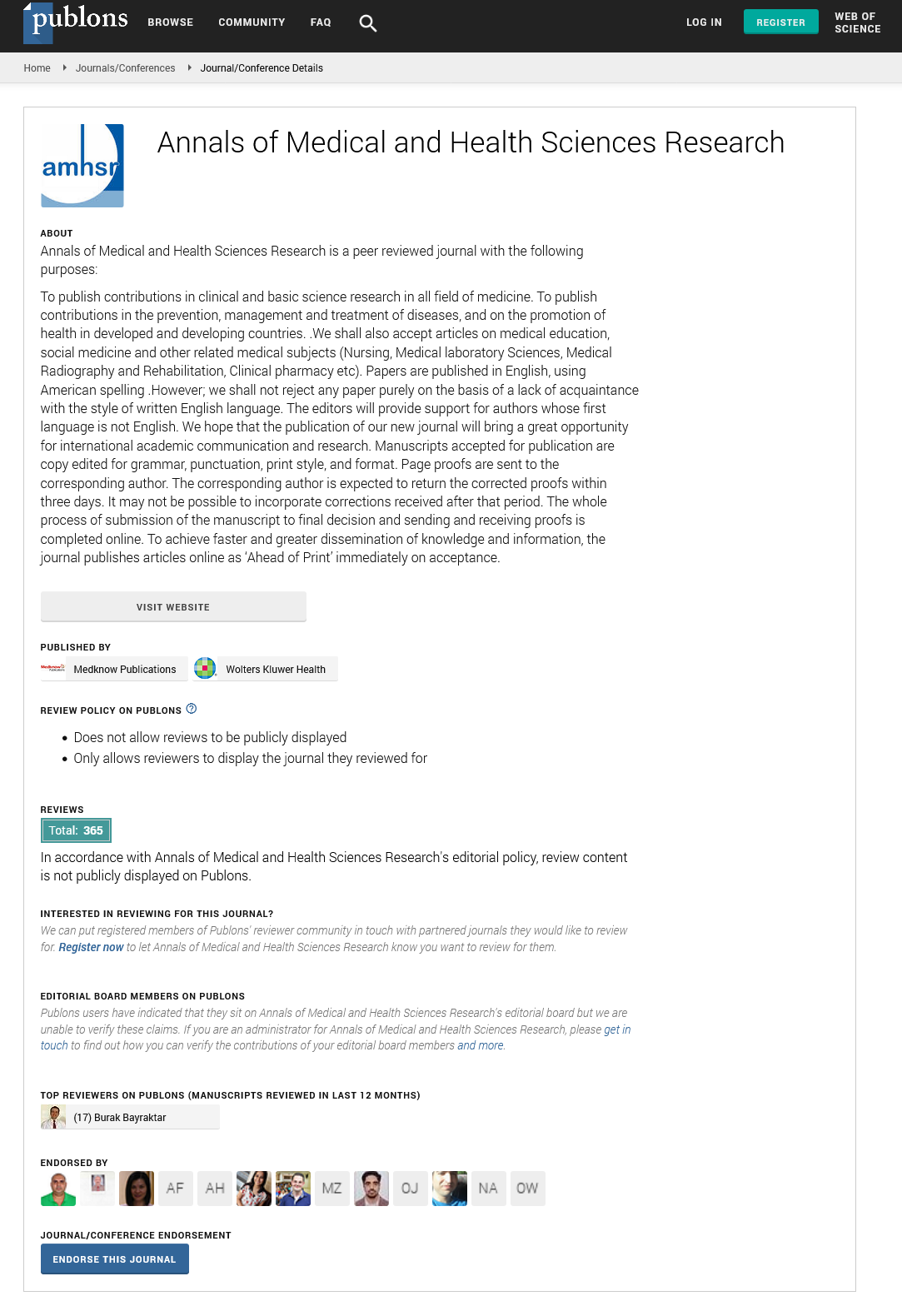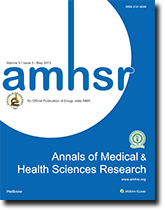Adult Reversed Midgut Malrotation with Ileosigmoid Knoting: A Case Report
2 Department of Endocrinology, St.Paulos Millenum Medical College, Addis Ababa, Ethiopia
Received: 25-Nov-2024, Manuscript No. amhsr-24-153217; Editor assigned: 27-Nov-2024, Pre QC No. amhsr-24-153217 (PQ); Reviewed: 11-Dec-2024 QC No. amhsr-24-153217; Revised: 18-Dec-2024, Manuscript No. amhsr-24-153217 (R); Published: 26-Dec-2024
Citation: Kassaw Y. Adult Reversed Midgut Malrotation with Ileosigmoid Knoting: A Case Report. Ann Med Health Sci Res. 2024; S4 1057-1059.
This open-access article is distributed under the terms of the Creative Commons Attribution Non-Commercial License (CC BY-NC) (http://creativecommons.org/licenses/by-nc/4.0/), which permits reuse, distribution and reproduction of the article, provided that the original work is properly cited and the reuse is restricted to noncommercial purposes. For commercial reuse, contact reprints@pulsus.com
Abstract
Ileosigmoid Knotting (ISK) is a rare cause of acute intestinal obstruction involving ileum and sigmoid colon entanglement, classified into types I to IV and classes 1 to 6 based on mortality risk factors. Reversed rotation of the midgut, a rare malrotation anomaly, results from clockwise embryonic rotation, causing duodenal and transverse colon positional reversal. Clinical suspicion of midgut malrotation arises from obstruction symptoms, often requiring urgent surgical intervention in neonates and definitive care in adults.
Keywords
Knotting; Ileum; Colon; Adult; Mesenteric; Artery
Introduction
Ileosigmoid Knotting (ISK) involves wrapping the ileum around the sigmoid colon and its mesentery or vice versa. The incidence of ISK is not well known, but it generally occurs in areas with a high incidence of sigmoid volvulus and it is common in adult males. The etiology of ISK is controversian [1]. ISKs are classified into four types: Types I, II, III and undetermined. In type I, the ileum revolves around the sigmoid colon; in type II, the sigmoid colon revolves around the ileum; in type III, the ileocecal segment revolves around the sigmoid colon; and in the undetermined type, it is impossible to determine the revolved segment [2]. On the other hand, in 2009, when some preoperative and operative criteria that are correlated with mortality were used, a new classification system was described for surgically treated ISK [3]. In the new classification, patients with ISK are classified as follows: Class 1, patients with no risk factor (advanced age and associated disease); class 2, those with no shock or bowel gangrene but other risk factors mentioned above; class 3, those with shock; class 4, those with ileum or sigmoid colon gangrene; class 5, those with both shock and ileum or sigmoid colon gangrene and class 6, those with both ileum and sigmoid colon gangrene [3].
Reversed rotation of the midgut, the rarest presentation of Intestinal malrotation, accounts for only 2%–4% of all embryonic mid gut rotational anomalies. It is twice as common in women as men [4]. First described in the late 1800s, reversed rotation occurs when the midgut loop erroneously rotates in a clockwise direction. As a result, the duodenum and the transverse colon are reversed in position; the transverse colon lies posterior to the superior mesenteric artery and the duodenum lies anteriorly. Reversed rotation occurs when the postarterial segment of the midgut returns to the abdomen first. The cecum begins migrating and passes to the right behind the superior mesenteric artery. This reversed migration unwinds the normal counterclockwise rotation that occurs during the first stage and replaces a final clockwise rotation of 90°, so that the transverse colon lies behind the duodenum and is separated from it by the superior mesenteric artery [5].
Clinical diagnosis of reversed rotation is not possible, but suspicion of midgut malrotation may be raised by the presenting symptoms and signs. The reversed rotation may lead to volvulus of the mobile right colon or the entire midgut, stenosis of the transverse colon because of pressure on it in the retro-arterial tunnel, or obstruction at the duodenojejunal junction because of pressure from lad’s bands or volvulus. In neonates and infants, this condition presents as acute intestinal obstruction necessitating immediate surgical attention; in adults, intermittent subsiding bouts of bowel obstruction, resulting in definitive surgical care only after several episodes, are more common [6].
Case Presentation
A 50 year old male patient presented with abdominal pain of 15 hours duration, which was sudden onset and crampy in type, with associated vomiting of 3 episodes, abdominal distension and failure to pass feces and flatus.
On physical examination, the general appearance of the patient was as follows: Acute sick looking at pain, vital signs, a Blood Pressure (BP) of 100/70, Pulse Rate (PR) 100 which is regular, Respiratory Rate (RR) of 20, which is afebrile, HEENT (Head, Ears, Eyes, Nose, Oral, Throat) dry bucal mucosa, pink conjunctiva and nonicteric schelera and no lymphadenopathy. Respiratory system: Clear chest with good air entry and comparable breath sounds bilaterally. Cardiovascular systems S1 and S2 heard well no murmurs. Abdomen distended and abdomen doesn’t move with respiration has diffuse both direct and rebound tenderness, absent bowel sounds and per rectal examination empty rectum, hyper tympanic on percussion and Hernia sites are free. The other systems are not affected.
The Complete Blood Count (CBC) revealed a White Blood Cells (WBC) count of 8140 with neutrophil count of 72%, Hemoglobin (HgB) of 10.6 gm/dl and platelet count of 260,000/ dl. He was not scanned because he had peritonitis. The diagnosis was generalized peritonitis secondary to ruling out gangrenous sigmoid volvulus.
The Intravenous (IV) line was secured, resuscitated with 3 bags of Normal Saline (NS), catheterized and had 200 ml of urine output upon insertion. The Nasogastric Tube (NG) tube was inserted and had minimal output and antibiotics, ceftriaxone 1 gm and metronidazole 500 mg IV were started.
Operation, midline extended laparotomy was performed. Intraoperative findings revealed that approximately 1000 ml of hemorrhagic fluid was present, the sigmoid colon was twisted 720 degrees counter clockwise and the 2nd twist included the distal ileum (Figure 1). There was an ischemic change in the entangled small bowel and sigmoid colon, which was redundant (174 cm) and frankly gangrenous (Figure 2).
The cecum was found to be Right Upper Quadrant (RUQ), ascending colon was Right Lower Quadrant (RLU), the transverse colon posterior to the small bowel mesentery and SMA and cecum and the ascending colon and transverse colon were distended and nonobstructive (Figure 3).
Untwisting the volvulus, hot pack was applied to the ischemic small bowel, resection of gangrenous sigmoid was performed, the distal stamp was closed to the proximal part (descending colon) exteriorized as the end colostomy and appendectomy were performed and the general peritoneum was washed with warm NS sorely and closed in layers.
Postoperatively, the patient stayed for 5 days in the hospital and was taking ceftriaxone, metronidazole and dicofenac per need and tramadol 50 mg IV twice daily. He was discharged after 10 days, after which stich was removed and reappointed after 3 months for colostomy closure. The patient came to the hospital for colostomy closure after 3 months but was discharged without closure because there were many emergency patients due to local war. After 2 years, the patient returned and the colostomy was reversed and the patient remained in the ward for 7 days, after which he was discharged and improved. He was followed up after 10 days and the stich was removed. He was followed up again after 1 month and was not compliant.
Discussion
Upto our knowledge there is no case report with “Ileosigmoid knotting and reversed mal rotation” co-incidence. We need keep in mind as the diffential diagnosis for the patients with obstruction and know the management principles for the reversed malrotaion too. For case we didn’t do lads band release because the mesentery was large and nonobstructive. Otherwise doing appendectomy, lad’s band release are added procedures we need to do even though the patient is adult. Our patient is doing fine and started his regular work and comfortable.
Conclusion
As this case demonstrates, the incidence of malrotation should not be forgotten during laparotomy in adults to ensure prompt treatment to prevent rupture of the bowel and life-threatening complications and to perform the procedures needed.
Recognizing this rare but critical condition is paramount, as delayed or missed diagnosis can lead to significant morbidity and mortality. Surgeons should maintain a high index of suspicion, especially when dealing with atypical presentations of abdominal pain or bowel obstruction. Furthermore, proper preoperative imaging and intraoperative vigilance are essential for accurate diagnosis and management..
References
- Seruwagi TM, Lewis C. Ileosigmoid knotting: A case series. Cureus. 2022; 14(11).
- Alver O, Ören D, Tireli M, Kayabasi B, Akdemir D. Ileosigmoid knotting in Turkey: Review of 68 cases. Dis Colon Rectum. 1993; 36(12):1139-1147.
- Atamanalp SS, Oeztuerk G, Aydinli B, Yildirgan MI, Başoğlu M, et al. A new classification for ileosigmoid knotting. Turk J Med Sci. 2009; 39(4):541-545.
- Bhartiya A, Maqsood H, Naeem H, Nazar MW. Reversed intestinal malrotation presenting as bowel obstruction in pregnancy: Case report and literature review. Ann Med Surg (Lond). 2022; 82.
- Deniffel D, Goerke SM, Rummeny EJ, Laubenberger J. Novel variant of reversed midgut rotation retroarterial proximal jejunum and transverse colon: A case report and review of the literature. J Med Case Rep. 2018; 12:1-5.
- Gill SS, Eggleston FC. Acute intestinal obstruction. Arch Surg. 1965; 91(4):589-591.


 ) show the gangreneous
sigmoid.
) show the gangreneous
sigmoid.
 )
is cecum and the rectangle (
)
is cecum and the rectangle ( ) is appendix.
) is appendix.
 )
shows transverse colon and the octagon symbol (
)
shows transverse colon and the octagon symbol ( ) shows small bowel
mesentery.
) shows small bowel
mesentery.


 The Annals of Medical and Health Sciences Research is a monthly multidisciplinary medical journal.
The Annals of Medical and Health Sciences Research is a monthly multidisciplinary medical journal.